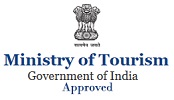Waking up to the dancing sunlight on the snowy peaks, watching the silvery green leaves rustle in the nippy breeze, listening to the roaring sound of the river next to camp and the possibility of adventure everyday – that is what awaits you on one of the most unique Himalayan treks – the Gaj Pass trail. Right in the heart of the Dhauladhar Range, this Himalayan trek is equal parts exciting and equal parts serenading. Nature’s bounty surrounds you on all sides as you climb your way along the tumultuous Gaj River to reach Bagga Dhar. And from here on, the adventurous side of the valley takes over, letting you cross moraine patches, test your limits, climb glaciers and reach the top to witness the most spectacular view you have ever seen. Gaj Pass can offer you all that and a whole lot more!
Gaj Pass is a Himalayan mountain pass located in Dhauladar Range in Himachal Pradesh. Its strategic location makes it the shortest and most viable route for those who wish to visit the Lam Dal or Lam Lake (a high altitude glacial lake that is considered sacred by local Himachali people). It is also an amazing short snow trek in the Himalayas. In itself, the pass is relatively lesser known as a commercial trekking alternative, although it is located quite close to many popular treks near Dharamshala like the Kareri Lake Trek and the Triund Trail. Even with famous neighbours such as the Indrahaar Pass, Minkhiani Pass and Bhim Gasturi Passes, this part of the Dhauladhars remains virtually unspoiled by tourist activity. It is thus, the perfect destination for any trekker or nature lover who wishes to witness the mountains and its people in their true, unadulterated form. The Gaj River descends down the valley, taking glacial waters from the snow accumulated in the Gaj and Indrahaar Pass glaciers. Densely packed with velvety green forests of deodars, fir, pines, walnuts and rhododendrons, the region offers unimaginable access to undisturbed Himalayan wildlife.
Even though the trek to Gaj Pass is not as famous on usual trekking or tourist circuits, it holds immense significance in the lives of the local inhabitants of the Kangra Valley. It is a highly favoured route of the Gaddi Shepherds of the region who use this pass to frequently cross over to Chamba with their flocks. Various Marhis or Shepherd hamlets can be found in the meadows on the Gaj Pass Trek route which are used as resting places by these nomads on their long journeys in the valley. The Lam Dal Lake, a high altitude glacial lake located in at an altitude of 3900 Mts is a highly revered place of worship for the locals of Kangra and Chamba. Krishna Janmashtami and Radha Ashtami are the two holy days when locals, no matter what age they may be, gather together and trek to the lake for a worshipful dip in the lake. Gal Pass happens to be the route of choice for this pilgrimage and therefore, holds extreme importance in the lives of the people of the valley. Gaj Pass also allows access to various other high altitude lakes of the region, many of which are considered sacred and are also quite important on the trekking circuit. These include the Kareri Lake, Kali Dal, Chander Koop Dal, Nag Dal and more. The Seven Lakes Trek of Dhauladhars can also be planned from this valley.
The undisturbed nature of this valley has allowed wildlife and nature to flourish extensively. Bird Watching is a highly coveted activity on the Gaj Pass trail with regular sightings of elusive birds such as the Himalayan Magpie, Himalayan Griffon Vulture, Minivets, Orioles, Himalayan Bulbuls, Pheasants, Green Barbets, Himalayan Woodpeckers, Francolins and more. Himalayan Brown Bears, Ibexes, Musk Deers, Barking Deers, Jungle Cats, Jackals, Red Foxes, Civets, Weasels, Himalayan Tahrs and even Snow Leopards have also been spotted around Gaj Pass and in the surrounding valley. The upper reaches of the valley remain mostly devoid of human settlement. The last hamlets end in Bonthu Village. This fact has ensured that the wildlife and the forest cover remains undisturbed. The only human activity happens during the annual pilgrimage by the locals and that too is confined to Bagga Dhar and the clearly marked trail that is usually used by the trekkers. All in all, Gaj Pass and the valley below is a heaven for nature lovers and adventure seekers looking to experience the Himalayas in their most unadulterated form.
- Gaj Pass Height: 4140 Mts
- Gaj Pass Mountain Range: Dhauladhars in the Himalayas
- Gaj Pass District: Kangra
- Nearest Town to Gaj Pass: Dharamshala
- Nearby Attractions to Gaj Pass: Lam Dal, Kareri Lake, Nag Dal, Kali Dal, Chandra Koop, Triund and Illaqa Got
- Passes Visible from Gaj Pass Trek: Minkhiani Pass, Bhim Gasturi Pass and Indrahaar Pass
- Peaks Visible from Gaj Pass Trek: Moon Peak
- River near Gaj Pass Trek: River Gaj
- Nearest Village to Gaj Pass: Bonthu
- Gaj Pass Weather:
- Summer – 26oC to 4oC in the Night, snow visible on peaks/passes and accessible in some glaciers
- Monsoon: 9oC to 18oC, regular rainfall, snow begins to melt away in most glaciers.
- Winters: 4oC to -15oC, snowfalls usually starting in January
Reaching Gaj Pass requires quite a lot of forward planning from the trekker’s end. The Gaj Pass trek begins from a fairly remote part of Himachal Pradesh. To reach the trek starting point, you will need to reach Village Ghera in District Kangra. To do that, you can either reach the Dharamshala airport at Gaggal or you can reach Dharamshala by a Volvo from Delhi or Chandigarh and take a short drive up to Ghera. The nearest train station to the valley is Pathankot which is roughly 118kms away from the base of the trek. The Gaj Pass trek begins in Bonthu near Village Ghera. The trail is fairly well marked but the undisturbed wildlife and unpredictable nature of the mountains are important factors to consider. Overall, you will need 4 – 5 days of trekking and camping in Himalayas to complete the trek (to and fro). From Bonthu, you will need to reach Bagga Dhar, from whereon the trek will take on a steep gradient, especially around the final leg. Himalayan treks can be extremely dangerous if you are new to the mountains or are unaware of the territory. It is always better to have a professional and experienced trekking guide or adventure tour operator manage it for you.
Trek Particulars
Duration: 4 Nights – 5 Days
Max Height: 3200Mts
Total Distance Covered: 31kms
Pick Up and Drop: Dharamshala
Snow: Guaranteed


